Defining Accounting Calendars
This topic provides an overview of accounting calendar setup, lists common elements, and discusses how to:
Define a base calendar.
Modify or add detail calendars.
Define summary calendars.
(Optional) Define business calendars.
(Optional) Define daily calendars.
(Optional) Define budget calendars.
Define calendar frequencies.
Define frequency details.
Define timespans.
Pages Used to Define Accounting Calendars
|
Page Name |
Definition Name |
Navigation |
Usage |
|---|---|---|---|
|
Calendar Builder |
CALENDAR_BUILDER |
|
Define a base calendar to be used by other calendars that you create. The calendar that you create is by default a detail calendar. |
|
Detail Calendar |
DETAIL_CALENDAR1 |
|
Modify or add detail accounting calendars that match or differ from your general ledger calendars. |
|
Summary Calendar |
SUMMARY_CALENDAR |
|
Define a summary calendar to group or combine periods from detail calendars. |
|
Summary Budget Period Calendar |
SUMMARY_BP_CAL |
|
Define a summary budget period calendar to group or combine periods from detail calendars. |
|
Business Day Calendar |
BUS_CALENDAR |
|
Define a business calendar to specify your normal business week and the holidays observed by your banks. |
|
Daily Calendar |
DAILY_CALENDAR |
|
Define a daily calendar for reporting purposes. |
|
Budget Calendar |
CAL_BP_TBL |
|
Define a budget calendar for controlled budget processing. |
|
Frequency Definition |
PF_FREQUENCY_DEFN |
|
Define calendar frequencies. Add and modify frequency definitions. |
|
Frequency Details |
PF_FREQUENCY_DTL |
|
Define frequency details by assigning the frequencies to calendars. |
|
TimeSpan |
TIME_SPAN |
|
Define timespans. |
Understanding Accounting Calendar Setup
In PeopleSoft systems, you can establish an accounting period configuration based on the beginning and ending period dates that you normally use and combine these periods to create accounting calendars. These calendars define the time periods to which you post transactions or create reports for different ledger group and business unit combinations. You select the calendar that defines the periods for a business unit and ledger group combination.
You can maintain an unlimited number of accounting periods over any span of years. You can maintain traditional monthly periods, including an additional adjustment period, or you can define your own periods.
Note: In the PeopleSoft EPM product line, calendars are used mostly for reporting. However, for the system to properly handle data (for example, general ledger data) from your transaction database, you must be sure that the detail calendars match those in your transaction accounting system. You can move calendars from your PeopleSoft transaction database into your PeopleSoft EPM database using PeopleTools such as Data Mover.
The PeopleSoft system supports multiple calendars, so you can keep one calendar for actuals, another for budget and forecast activity, and still others for special reporting needs. Because you store calendars in tables, you can share them across business units, helping to provide consistency in period dates and easing the process of acquisition and consolidation.
PeopleSoft uses the following calendar definition options:
Calendar Builder Page
Use the Calendar Builder page (CALENDAR_BUILDER) to define a base calendar to be used by other calendars that you create. The calendar that you create is by default a detail calendar.
Image: Calendar Builder page
This example illustrates the fields and controls on the Calendar Builder page. You can find definitions for the fields and controls later on this page.
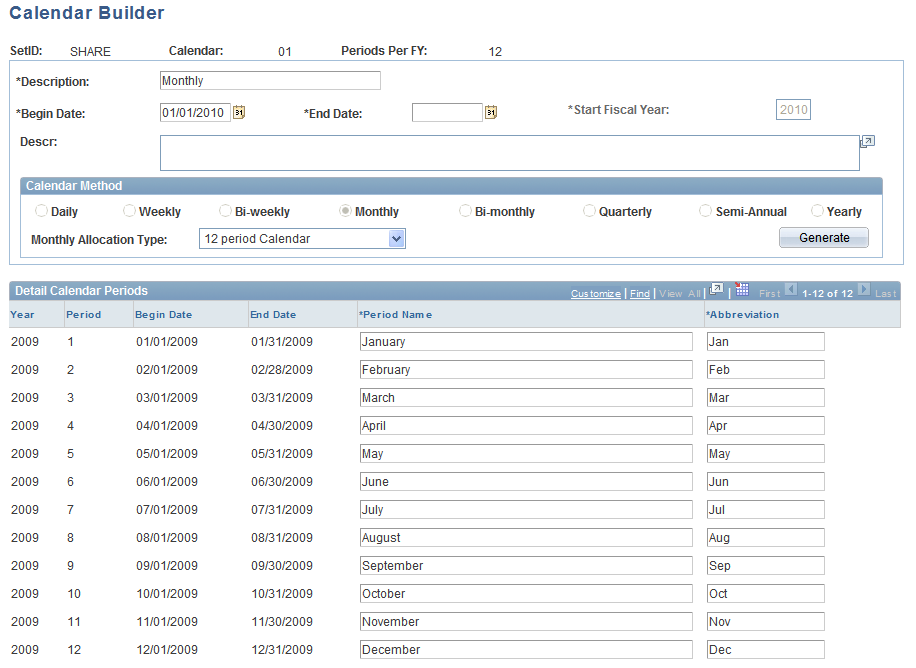
Note: As you define calendars, keep in mind that in all instances in which a PeopleSoft EPM warehouse business unit is related to a general ledger business unit, the calendars for the business units should be the same. Warehouse business units are described elsewhere in this topic.
After you have saved a calendar using the calendar builder, you can only modify the calendar description or long description on the Calendar Builder page. If you need to modify the saved calendar further, use the other calendar pages, (for example the Detail Calendar page).
By default, a calendar that you create with the Calendar Builder is a detail calendar.
Detail Calendar Page
Use the Detail Calendar page (DETAIL_CALENDAR1) to modify or add detail accounting calendars that match or differ from your general ledger calendars.
Image: Detail Calendar page
This example illustrates the fields and controls on the Detail Calendar page. You can find definitions for the fields and controls later on this page.
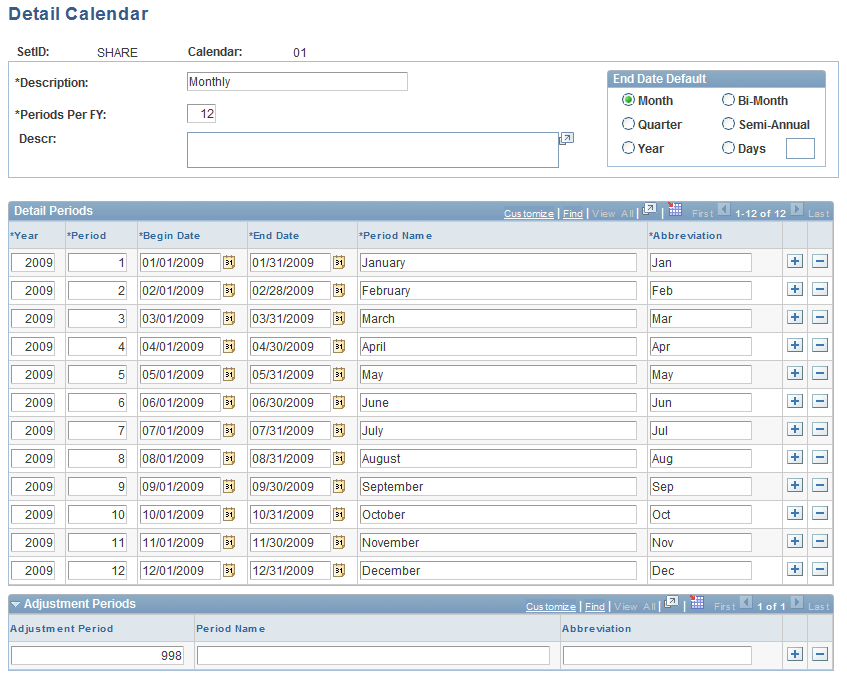
You create detail calendars using the Calendar Builder. Use this page to modify calendars after they have been created.
When you enter period dates, you can define monthly calendar periods or any fiscal period that matches your accounting calendar (such as weekly or bimonthly) as long as the beginning and ending dates of successive periods don't overlap. Every day of the year must be included in a period; you cannot leave gaps between period dates. Make sure that your detail calendar includes a period for the oldest transaction that you want to enter. After installing your PeopleSoft system, you might want to make this earliest date more restrictive.
You will need to return to this page to enter ensuing years manually. You can enter several years at a time or treat the task as part of your end-of-year system maintenance.
After you define your detail calendar, you can use it to manage open periods for the generation of journals. You can also use it to define the periods that store summarized results in a summary ledger.
Note: The MODEL calendar delivered with your system contains data from 1957 to 2025. You can use the MODEL calendar rather than entering your own data; if you do so, make a copy of MODEL first, and make changes to the copy.
Summary Calendar Page
Use the Summary Calendar page (SUMMARY_CALENDAR) to define a summary calendar to group or combine periods from detail calendars.
Image: Summary Calendar page
This example illustrates the fields and controls on the Summary Calendar page. You can find definitions for the fields and controls later on this page.
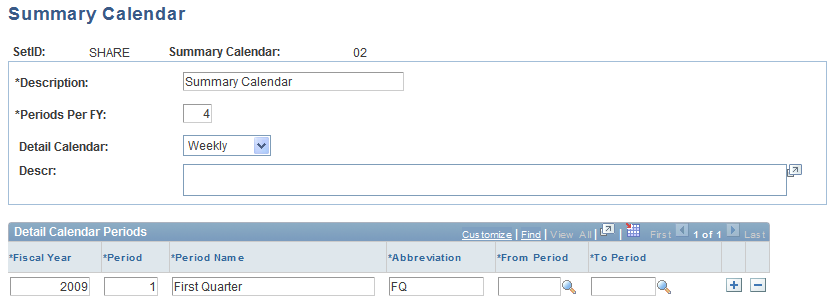
Consider the following when setting up summary calendars. A quarterly summary calendar, for example, might have four periods, each consisting of three periods from a monthly detail calendar. A summary calendar can also combine cumulative detail calendar accounting periods to create year-to-date balances. Summary calendars are especially useful for determining how your models will roll up for reporting purposes. As with detail calendars, you can include as many fiscal years as you need in one summary calendar.
Enter a description and periods per fiscal year to specify the number of periods in the accounting year for this calendar.
| Detail Calendar |
Select the ID of the detail calendar on which this calendar is based. Every summary calendar must be based on a detail calendar. |
Supply the fiscal year, period, period name, and abbreviation.
| From Budget Period and To Budget Period |
Enter the detail calendar periods to be summarized in each summary period. |
Note: You can define as many years on a calendar as necessary. Be sure to include any years that you use to store historical information.
Summary Budget Period Calendar Page
Use the Summary Budget Period Calendar page (SUMMARY_BP_CAL) to define a summary budget period calendar to group or combine periods from detail calendars.
Image: Summary Budget Period Calendar page
This example illustrates the fields and controls on the Summary Budget Period Calendar page. You can find definitions for the fields and controls later on this page.

Summary calendars are especially useful for determining how your models will roll up for reporting purposes. Enter a description, budget period, and from/to periods to specify the number of budget periods in the accounting year for this calendar.
Business Day Calendar Page
Use the Business Day Calendar page (BUS_CALENDAR) to define a business calendar to specify your normal business week and the holidays observed by your banks.
Image: Business Day Calendar page
This example illustrates the fields and controls on the Business Day Calendar page. You can find definitions for the fields and controls later on this page.

| Normal Business Days |
Select the business days of the week to include. |
| Notes |
Enter any notes to further describe this calendar. |
In the grid at the bottom of the page enter a row for each holiday on which you know businesses won't operate.
| Year and Date |
Specify the year and date for any holidays that you include. |
| Holiday Name |
Enter the name of the holiday on which your business does not operate. |
In multinational corporations, you accommodate the various locations and different holidays observed by defining as many business calendars as you need for each SetID.
Note: Business calendars determine the number of workdays in each month, for reporting purposes only.
Note: If you use PeopleSoft Asset Liability Management, Funds Transfer Pricing, or Risk-Weighted Capital, you must create a business day calendar to define your holidays.
Daily Calendar Page
Use the Daily Calendar page (DAILY_CALENDAR) to define a daily calendar for reporting purposes.
Image: Daily Calendar page
This example illustrates the fields and controls on the Daily Calendar page. You can find definitions for the fields and controls later on this page.

Remember to set up a calendar for each fiscal year. To display the detail periods for existing calendars, click the Update button.
Note: For leap years, you must change the periods per fiscal year value from 365 to 366 to create the last period for the leap year (for example, December 31, 2004).
Budget Calendar Page
Use the Budget Calendar page (CAL_BP_TBL) to define a budget calendar for controlled budget processing.
Image: Budget Calendar page
This example illustrates the fields and controls on the Budget Calendar page. You can find definitions for the fields and controls later on this page.
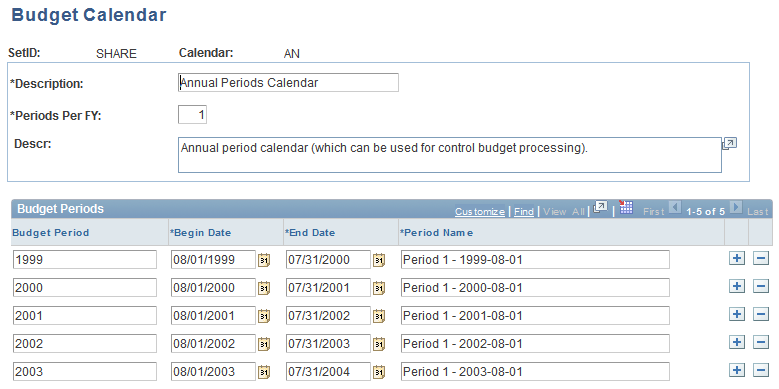
For budget calendars, you might want to enter a descriptive calendar ID such as AN for an annual calendar budget.
Enter the budget periods, begin and end dates, and period names.
Frequency Definition Page
Use the Frequency Definition page (PF_FREQUENCY_DEFN) to define calendar frequencies. Add and modify frequency definitions.
Image: Frequency Definition page
This example illustrates the fields and controls on the Frequency Definition page. You can find definitions for the fields and controls later on this page.
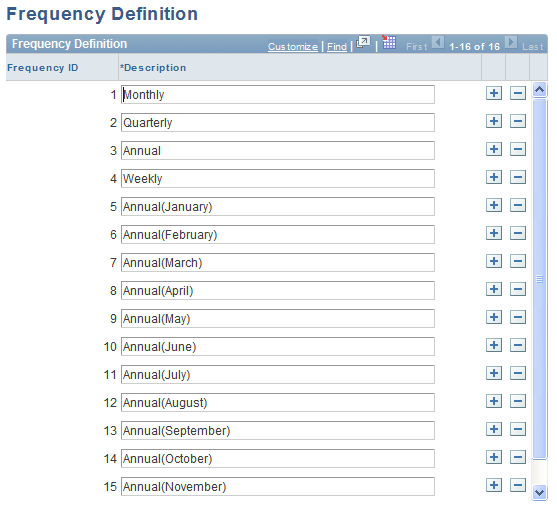
Define frequencies by adding a row with a description or by updating an existing description.
Note: The frequencies you define on this page will comprise the list of valid values in the Frequency Details page.
Frequency Details Page
Use the Frequency Details page (PF_FREQUENCY_DTL) to define frequency details by assigning the frequencies to calendars.
Image: Frequency Details page
This example illustrates the fields and controls on the Frequency Details page. You can find definitions for the fields and controls later on this page.

Timespan Page
Use the TimeSpan page (TIME_SPAN) to define timespans.
Image: Time Span page
This example illustrates the fields and controls on the Time Span page. You can find definitions for the fields and controls later on this page.
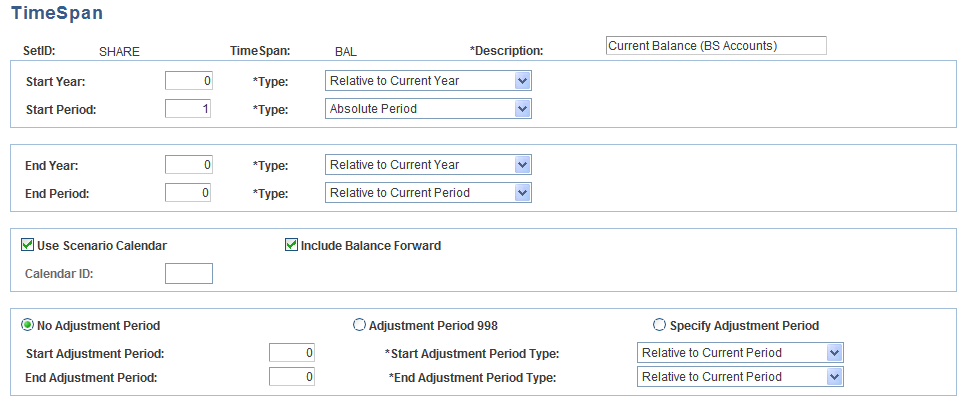
Note: Balance forward accounts store balance forward amounts. For example, in your regular accounting system you might want to specify asset, liability, and equity accounts as balance forward accounts, but not revenue or expense accounts. The account balance forward function rolls forward the accounts on any date specified for flexible year-end processing.
See the product documentation for PeopleSoft EPM: Global Consolidations